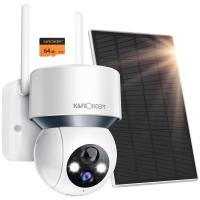How Are Solar Panels Made?
Solar panels, also known as photovoltaic (PV) panels, are a critical component in the renewable energy landscape. They convert sunlight into electricity, providing a sustainable and eco-friendly power source. Understanding how solar panels are made can help consumers make informed decisions about their energy choices and appreciate the technology behind this green energy solution. This article will delve into the intricate process of manufacturing solar panels, from raw materials to the final product, and address common questions and concerns.
The Basics of Solar Panel Technology

Before diving into the manufacturing process, it's essential to understand the basic technology behind solar panels. Solar panels are composed of many solar cells, which are the fundamental units that convert sunlight into electricity. These cells are typically made from silicon, a semiconductor material that is abundant and has excellent electrical properties.
Step-by-Step Manufacturing Process

1. Raw Material Extraction
The primary material used in solar cells is silicon, which is derived from sand. The process begins with the extraction of high-purity quartz, which is then refined into metallurgical-grade silicon. This silicon is further purified to produce polysilicon, the raw material for solar cells.
2. Ingot Formation
The purified polysilicon is melted and formed into ingots. There are two main types of ingots used in solar panel production: monocrystalline and polycrystalline. Monocrystalline ingots are made from a single crystal structure, resulting in higher efficiency but at a higher cost. Polycrystalline ingots are made from multiple crystal structures, which are less efficient but more cost-effective.
3. Wafer Production
The ingots are then sliced into thin wafers using a wire saw. These wafers are typically about 200 micrometers thick. The slicing process must be precise to ensure uniformity and minimize waste. The wafers are then cleaned to remove any impurities or debris.
4. Doping
To enhance the electrical properties of the silicon wafers, a process called doping is used. Doping involves adding small amounts of other elements, such as phosphorus or boron, to create a positive (p-type) or negative (n-type) charge. This process is crucial for creating the p-n junction, which is essential for the photovoltaic effect.
5. Anti-Reflective Coating
Silicon wafers naturally reflect a significant amount of sunlight, which can reduce the efficiency of the solar cells. To mitigate this, an anti-reflective coating is applied to the surface of the wafers. This coating, usually made of silicon nitride, helps to increase the amount of light absorbed by the cells.
6. Metal Contacts
To collect and transport the electricity generated by the solar cells, metal contacts are added to the front and back of the wafers. These contacts are typically made of silver or aluminum and are applied using a screen-printing process. The front contacts are designed in a grid pattern to allow maximum light exposure while minimizing resistance.
7. Cell Testing and Sorting
Once the solar cells are complete, they undergo rigorous testing to ensure they meet quality and performance standards. Cells are sorted based on their efficiency and electrical characteristics. This sorting process is essential for creating solar panels with consistent performance.
8. Module Assembly
The sorted solar cells are then assembled into solar panels. This involves arranging the cells in a grid pattern and connecting them with metal ribbons. The cells are encapsulated in a protective material, usually ethylene-vinyl acetate (EVA), and sandwiched between a tempered glass front and a durable backsheet. The entire assembly is then framed, typically with aluminum, to provide structural support.
9. Lamination and Sealing
The assembled solar panel undergoes a lamination process, where it is heated and pressed to bond the layers together. This step ensures the panel is weatherproof and can withstand environmental conditions. The edges of the panel are sealed to prevent moisture ingress, which can degrade performance over time.
10. Final Testing and Quality Control
The finished solar panels are subjected to a series of tests to verify their performance, durability, and safety. These tests include electrical performance testing, mechanical load testing, and environmental stress testing. Panels that pass these tests are certified and ready for installation.
Addressing Common Questions and Concerns

1. Environmental Impact
One common concern about solar panel manufacturing is its environmental impact. While the production process does involve energy and resource consumption, the overall environmental footprint of solar panels is significantly lower than that of fossil fuels. Advances in manufacturing technology and recycling programs are continually reducing the environmental impact of solar panel production.
2. Efficiency and Lifespan
The efficiency of solar panels has improved significantly over the years, with modern panels converting up to 22% of sunlight into electricity. The lifespan of solar panels is typically around 25-30 years, with many manufacturers offering warranties that guarantee performance over this period. Regular maintenance and proper installation can further extend the lifespan of solar panels.
3. Cost and Accessibility
The cost of solar panels has decreased dramatically over the past decade, making them more accessible to a broader range of consumers. Government incentives, tax credits, and financing options have also made it easier for homeowners and businesses to invest in solar energy. While the initial investment can be substantial, the long-term savings on energy bills and the environmental benefits make solar panels a worthwhile investment.
4. Technological Advancements
The solar industry is continually evolving, with ongoing research and development aimed at improving efficiency, reducing costs, and enhancing the sustainability of solar panels. Innovations such as bifacial panels, which capture sunlight from both sides, and perovskite solar cells, which offer higher efficiency at a lower cost, are promising developments that could revolutionize the industry.
The manufacturing process of solar panels is a complex and precise operation that transforms raw materials into high-tech energy solutions. Understanding this process can help consumers appreciate the technology behind solar panels and make informed decisions about their energy choices. As the demand for renewable energy continues to grow, advancements in solar panel technology and manufacturing will play a crucial role in shaping a sustainable future. By investing in solar energy, individuals and businesses can contribute to reducing carbon emissions and promoting a cleaner, greener planet.














There are no comments for this blog.